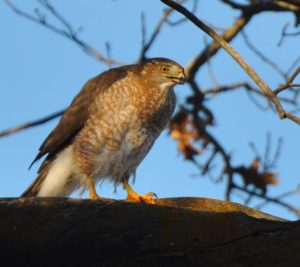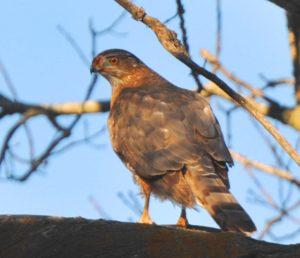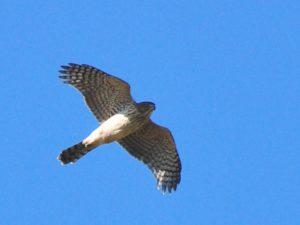Photography courtesy of Lowell Washburn, all rights reserved.
The woman at the opposite end of the phone line was — well, she was hysterical. Absolutely in a rage, and that’s putting it mildly. Whenever she’d stop to take a breath, I’d seize the opportunity to try working in a few words of my own. Didn’t work. Before I’d get half way through the first sentence, off she’d go again. At first I was confused, but eventually I began to connect the dots. As near as I could tell, here’s what had happened.
The caller was an avid birder. While enjoying an early morning cup of tea and peacefully observing the bustling activity around the backyard feeders, a hawk had suddenly burst on the scene. Winter tranquility was replaced by instant chaos. Following a brief chase, the hawk had caught and subdued a dove which, at the time of the call, was apparently being plucked and eaten directly beneath the lady’s kitchen window. The event was entirely unacceptable. Something needed to be done.
Hawks eating doves is nothing new, of course. I suspect it’s been going on for a long long time. Although certainly a more recent phenomena, hawks visiting backyard bird feeders is also nothing out of the ordinary. Happens all the time, in fact. In almost all cases, the offending raptors are either sharp-shinned hawks or Cooper’s hawks. Both are woodland species — characterized by short wings, long tails, and extreme bursts of speed.
Although a person cannot help being impressed with the hawks’ streamlined beauty and impressive displays of speed, they are regarded as unwelcome visitors at most feeders. Whenever these speedy hunters do come calling, the reaction to these “True Life Adventures” usually becomes charged with emotion and, sometimes, is downright hostile.
A minority of the people I’ve talked to [all males but for three exceptions] have been thrilled at having the chance to witness the predator/prey relationship play out in their very own backyards. They mainly call just to share what they’ve seen — like the Cooper’s hawk snagging a dove. For most people, the event represents a first time opportunity to observe as a wild hawk chases, catches, plucks, and finally consumes its prey.
The vast majority of folks, however, have a very different view. They are anything but thrilled. Most are frustrated. Nearly all are angry — some extremely so — over what they perceive as the calculated murder of innocent songbirds at the hands, or more properly the talons, of a ruthless hawk.
I must admit that they do have a point. Songbirds are innocent. Hawks are indeed ruthless. But another point worth considering, and this where the phone conversation usually starts going south, is that hawks chasing and eating other birds is just part of the natural order of things – a classic example of the food chain in action.
In order to meet daily high energy [caloric] demands and survive the rigors of an Iowa winter, all birds — including birds of prey — must become adept at finding and exploiting existing food supplies. Once snow cover and cold weather arrives, it doesn’t take long for neighborhood birds to key in on groups of well maintained backyard feeders. As word spreads, more and more birds flock in.
Hawks do the same. The only difference is that, instead of feeding at the birdseed end of the buffet line, they go straight for the red meat.
Here’s a thumbnail version of how the backyard food chain works. Put out lots and lots of bird seed, and you attract lots and lots of birds. Attract lots of birds, and you might attract a roving hawk.
Attracting a roving hawk is not bad. To the contrary, it’s a sure sign of a highly successful bird feeding program. I like to think of hawks as taking backyard bird feeding to its next, and highest, level.
Not everyone gets a hawk. But if a wintering raptor does eventually pay you a visit, one of two things will happen. The hawk will either chase and catch its meal; or it will chase and miss its meal. Either way, the raptor will move on to quietly digest its food, or it will go hunting for more things to chase. In either event, normal bird feeder activity will resume within minutes.
My advice is always the same. If someday a hawk does show up at your house — relax and enjoy the show. If you can’t do that, then I suggest brewing a second cup of tea. By the time you return, it will be as if nothing happened.




 Susan Judkins Josten
Susan Judkins Josten Rudi Roeslein
Rudi Roeslein Elyssa McFarland
Elyssa McFarland Mark Langgin
Mark Langgin Adam Janke
Adam Janke Joe Henry
Joe Henry Sue Wilkinson
Sue Wilkinson Tom Cope
Tom Cope Kristin Ashenbrenner
Kristin Ashenbrenner Joe Wilkinson
Joe Wilkinson Dr. Tammy Mildenstein
Dr. Tammy Mildenstein Sean McMahon
Sean McMahon